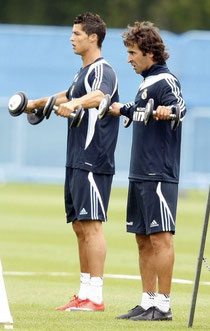
As the US soccer season has just started we would like to elaborate on an article by Ronnestadt et al. (2011) (1) (references below) who investigated the effect of different strength training frequencies in-season for the maintenance of strength, jump and sprint abilities in professional soccer players.

We are aware that university/collegiate athletes are not necessarily professional athletes and that both the academic plus the athletic schedule puts high load on the players (and especially this is the reason why you should consider the in-season strength training frequency carefully – also see Kraemer et al. 2004 (2) – who measured a decline in performance due to overtraining). However, the soccer system in the USA sees the University as the pool for potential Major League soccer players and therefore the training load is very high in college/university soccer and might even be comparable to Major League soccer.
Before we start discussing the article, we would like to give some thoughts on strength training in pre- vs. in-season. We are aware of the fact that the pre-season in college/university soccer
last only between 7-14 days, therefore the players need to have a solid foundation of every physiological aspect required in soccer before they come to the college/university. With regards to the
limited amount of time (with the team during pre-season), strength training with the purpose to specifically enhance jumping and sprinting seems questionable. We are not aware of any strength
training regime in soccer players that showed improvements in sprinting and jumping within two weeks.
So how can strength training be used during in-season?
Generally, we believe that it can be used to improve strength, sprinting and jumping abilities of players, however changes might be seen after 8-10 weeks and with a training frequency of 2-3
times per week. It seems that with the regular college/university soccer schedule, this might be hard to achieve.
The article by Ronnestadt et al. (2011) described the second purpose of strength training during in-season – the maintenance of strength, jumping and sprinting ability throughout the
season.
The authors setup two groups, one with a strength training frequency of once per week, the second group with a training frequency of once per two weeks. The purpose was to see differences after a
12 week period.
The group with one session per week maintained the desired variables, while the group which trained once every two weeks decreased in strength (10 ± 4%) and sprint (1 ± 0.3%) performance
significantly. Furthermore, the above mentioned article by Kraemer et al. (2004) utilized two strength training sessions per week and showed also a decline in performances.
As a conclusion, strength training needs to be implemented throughout a competitive soccer season to counteract on the negative effect of endurance based training and simultaneously maintain
strength, jumping and sprinting abilities of soccer players. It seems that there is an optimal dose-response relationship. In order to maintain strength, jumping and sprinting qualities of
players throughout 12 weeks/the season, one strength training per week seems to be sufficient.
References
1. Ronnestad, B. R., B. S. Nymark and T. Raastad. Effects of In-season
Strength Maintenance Training Frequency in Professional Soccer Players. J. Strength. Cond. Res. 25(10): 2653-2660, 2011.
2. Kraemer, W. J., et al. Changes in exercise performance and hormonal
concentrations over a big ten soccer season in starters and nonstarters. J. Strength. Cond. Res. 18(1): 121-128, 2004.
 Footballscience.net
Footballscience.net
